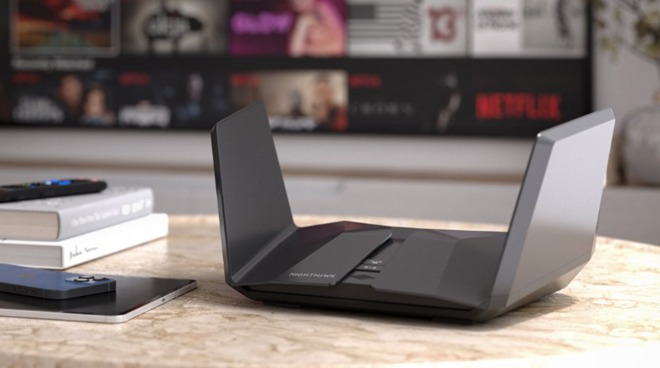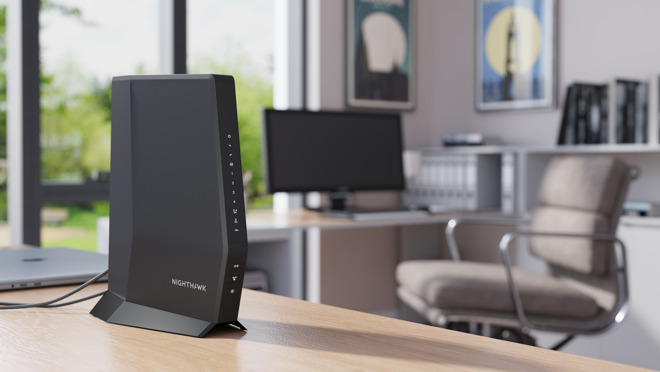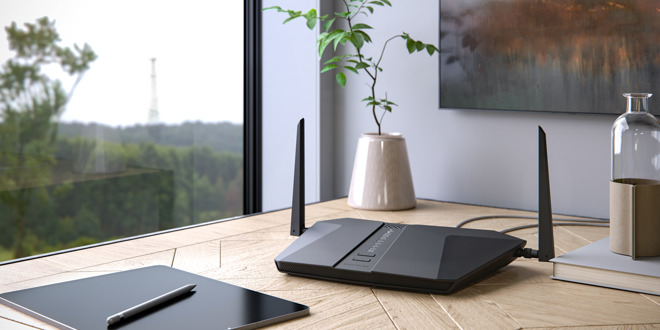Netgear's Nighthawk router product line gains a Wi-Fi 6E option
Netgear's CES lineup is headed up by the Nighthawk RAXE500, a tri-band Wi-Fi 6E router that takes advantage of freed-up 6GHz bands to offer speeds of up to 10.8Gbps.

Netgear Nighthawk RAXE500
The ability to use 6Ghz bands means there's more bandwidth available to use, which can increase speeds and the capacity for multiple networks to operate in the same space. In the Nighthawk RXAE500, Netgear claims this offers up to 200% more spectrum than dual-band Wi-Fi using 5GHz and 2.4GHz.
The router is capable of handling up to 12 streams of tri-band Wi-Fi, with four streams in each of the 6GHz, 5GHz, and 2.4GHz bands. This is said to help provide low latencies for gaming, as well as triple the number of high-bandwidth 160MHz Wi-Fi channels for streaming.
Powering the router is a Wi-Fi 6E-optimized processor, a 64-bit 1.8Ghz quad-core chip that will be able to handle 8K UHD streaming. To simplify its usage, the antennas of the router are pre-optimized, requiring users to unfold them with no further adjustments required.
Wired networking is provided by five Gigabit Ethernet ports, with the added ability to aggregate two LAN ports and two WAN ports for even faster connections. One of the Ethernet ports is a 2.5G version, providing faster-than-Gigabit connectivity.
For security, the router will include automatic firmware updates, as well as a 30-day trial of Netgear Armor, a cybersecurity system combining antivirus, anti-malware, and data protection for connected devices. Two USB 3.0 ports are also included.
Like other Nighthawk models, it can also be configured via a companion app, which can enable users to pause Internet connections for specific devices, as well as to monitor traffic usage over time, set up guest Wi-Fi connections, update the firmware, and other essential tasks.
Netgear plans to ship the Nighthawk RAXE500 Tri-band Wi-Fi router in the first quarter, priced at $599.99.

Netgear Nighthawk CAX30
The router element is a dual-band router running Wi-Fi 6, complete with 3x3 multi-user MIMO and intelligent scheduling. Capable of handling Ultra HD streams to multiple devices, it can produce speeds of up to 2.7Gbps.
Running a dual-core 1.5Ghz processor said to be optimized for the router's connectivity, the device also has four Gigabit Ethernet LAN ports and a USB 3.0 port for connecting storage devices to the network.
Set-up is handled by the Netgear Nighthawk app, which can be used for installation and configuration, and to check the status of the network. The app can be used to also pause connectivity on specific devices, track Internet usage, set up separate Wi-Fi access for guests, and even run a speed test.
Again, Netgear Armor is offered for network and device protection, including notifications when malicious threats are detected as well as blocking viruses, spyware, malicious links, and scanning for smart home device vulnerabilities.
Available in January and supporting Xfinity, Spectrum, and Cox, the Nighthawk AX6/6-Stream Wi-Fi 6 Cable Modem Router costs $299.99

Netgear Nighthawk LAX20
This would be advantageous for maintaining a connection for smart home users, such as those using HomeKit, as it will ensure connected devices will be accessible at all times.
Connecting over Wi-Fi 6, the router's ability to provide up to four streams and having 1024 QUAM enables it to run at up to 1.8Gbps across 5GHaz and 2.4Ghz bands, complete with 160MHz channel support.
For wired networking, there are four Gigabit Ethernet LAN ports along with a WAN Ethernet port. A USB 2.0 port is also included for adding an external USB hard drive for extra network storage.
Also on the back is the slot for a nano SIM card, enabling LTE connectivity. The router is supported by major carriers including AT&T, T-Mobile, and others, and can use either a carrier-supplied SIM or the one included in the box.
Support for the Nighthawk app and Netgear Armor are also included, offering ways to configure and manage the network from an iPhone or iPad, as well as protecting it from threats.
Now available in the United States, the Nighthawk AX4 is priced at $299.99.
AppleInsider will be covering the 2021 all-digital Consumer Electronics Show starting on January 11 through January 14 where we're expecting Wi-Fi 6e devices, HomeKit, Apple accessories, 8K monitors and more. Keep up with our coverage by downloading the AppleInsider app, and follow us on YouTube, Twitter @appleinsider and Facebook for live, late-breaking coverage. You can also check out our official Instagram account for exclusive photos throughout the event.

Netgear Nighthawk RAXE500
Nighthawk RAXE500 Wi-Fi 6e router
Revealed on Monday, the Netgear Nighthawk RAXE500 is a high-performance tri-band router that operates in the usual ranges of 2.4GHz and 5GHz for Wi-Fi 4, 5, and 6. With regulators moving to make 6GHz accessible by networking appliances, Netgear has added Wi-Fi 6e support, allowing the router to communicate with more available bandwidth than previously offered.The ability to use 6Ghz bands means there's more bandwidth available to use, which can increase speeds and the capacity for multiple networks to operate in the same space. In the Nighthawk RXAE500, Netgear claims this offers up to 200% more spectrum than dual-band Wi-Fi using 5GHz and 2.4GHz.
The router is capable of handling up to 12 streams of tri-band Wi-Fi, with four streams in each of the 6GHz, 5GHz, and 2.4GHz bands. This is said to help provide low latencies for gaming, as well as triple the number of high-bandwidth 160MHz Wi-Fi channels for streaming.
Powering the router is a Wi-Fi 6E-optimized processor, a 64-bit 1.8Ghz quad-core chip that will be able to handle 8K UHD streaming. To simplify its usage, the antennas of the router are pre-optimized, requiring users to unfold them with no further adjustments required.
Wired networking is provided by five Gigabit Ethernet ports, with the added ability to aggregate two LAN ports and two WAN ports for even faster connections. One of the Ethernet ports is a 2.5G version, providing faster-than-Gigabit connectivity.
For security, the router will include automatic firmware updates, as well as a 30-day trial of Netgear Armor, a cybersecurity system combining antivirus, anti-malware, and data protection for connected devices. Two USB 3.0 ports are also included.
Like other Nighthawk models, it can also be configured via a companion app, which can enable users to pause Internet connections for specific devices, as well as to monitor traffic usage over time, set up guest Wi-Fi connections, update the firmware, and other essential tasks.
Netgear plans to ship the Nighthawk RAXE500 Tri-band Wi-Fi router in the first quarter, priced at $599.99.

Netgear Nighthawk CAX30
Nighthawk CAX30 AX6/6-Stream Wi-Fi 6 Cable Modem Router
Another Nighthawk product introduced at CES is the Nighthawk CAX30 AX6/6-Stream Wi-Fi 6 Cable Modem Router. Supporting DOCSIS 3.1 with its built-in cable modem, it supports two OFDM downstream and two OFDMA upstream DOCSIS channels for faster and clearer data streaming.The router element is a dual-band router running Wi-Fi 6, complete with 3x3 multi-user MIMO and intelligent scheduling. Capable of handling Ultra HD streams to multiple devices, it can produce speeds of up to 2.7Gbps.
Running a dual-core 1.5Ghz processor said to be optimized for the router's connectivity, the device also has four Gigabit Ethernet LAN ports and a USB 3.0 port for connecting storage devices to the network.
Set-up is handled by the Netgear Nighthawk app, which can be used for installation and configuration, and to check the status of the network. The app can be used to also pause connectivity on specific devices, track Internet usage, set up separate Wi-Fi access for guests, and even run a speed test.
Again, Netgear Armor is offered for network and device protection, including notifications when malicious threats are detected as well as blocking viruses, spyware, malicious links, and scanning for smart home device vulnerabilities.
Available in January and supporting Xfinity, Spectrum, and Cox, the Nighthawk AX6/6-Stream Wi-Fi 6 Cable Modem Router costs $299.99

Netgear Nighthawk LAX20
Nighthawk LAX20 AX4 4G LTE Wi-Fi 6 Router
The Nighthawk LAX20 AX4 4G LTE Wi-Fi 6 Router is a hybrid device, that works as both a standard router that could be connected to a modem, as well as one that can use a 4G LTE connection. The router will automatically switch over to LTE in the event normal Internet service fails, enabling users to continue to have access throughout an outage.This would be advantageous for maintaining a connection for smart home users, such as those using HomeKit, as it will ensure connected devices will be accessible at all times.
Connecting over Wi-Fi 6, the router's ability to provide up to four streams and having 1024 QUAM enables it to run at up to 1.8Gbps across 5GHaz and 2.4Ghz bands, complete with 160MHz channel support.
For wired networking, there are four Gigabit Ethernet LAN ports along with a WAN Ethernet port. A USB 2.0 port is also included for adding an external USB hard drive for extra network storage.
Also on the back is the slot for a nano SIM card, enabling LTE connectivity. The router is supported by major carriers including AT&T, T-Mobile, and others, and can use either a carrier-supplied SIM or the one included in the box.
Support for the Nighthawk app and Netgear Armor are also included, offering ways to configure and manage the network from an iPhone or iPad, as well as protecting it from threats.
Now available in the United States, the Nighthawk AX4 is priced at $299.99.
AppleInsider will be covering the 2021 all-digital Consumer Electronics Show starting on January 11 through January 14 where we're expecting Wi-Fi 6e devices, HomeKit, Apple accessories, 8K monitors and more. Keep up with our coverage by downloading the AppleInsider app, and follow us on YouTube, Twitter @appleinsider and Facebook for live, late-breaking coverage. You can also check out our official Instagram account for exclusive photos throughout the event.

Comments
Unless you live in an urban area, 5G may be little more than a dream. Where I live, buried utilities are common. Telephone poles are considered unsightly - and let's face it, they are. I also have my doubts about 5G working reliably in older houses. I am reasonably close to my Verizon tower and the signal plummets inside my house and I am seriously considering installing a repeater. When I had Sprint I ended up using a femtocell to provide reliable service.
I would view fiber to (and in) the home to be a much better long term solution. But I am a Luddite.
My question (even if is not in the form of a question) is why Netgear (and others) are so quick to provide Wi-Fi6 (and 6e now) routers and cable modems, but are slow in introducing Wi-Fi 6(e) access points.
It's very obvious from using these monitoring apps that the peak performance for 5 GHz WiFi is much faster than the peak performance for 2.4 GHz WiFi, but at the expense of far more variation and fluctuation due to directionality and obstructions. Depending on your situation and physical obstructions, you may get faster average performance using 2.4 GHz rather than 5 GHz. As with any monitoring tool, measure, measure, and measure before you commit to making changes.
In general I've found that simple WiFi / IoT devices like smart plugs and smart speakers (like HomePod and Echo) work more reliably at 2.4 GHz. I also use 2.4 GHz for any device that I move around my home a lot, like iPhones, iPads, and MacBooks. I generally only use 5 GHz for stationary devices or for devices that always maintain a line-of-sight with the access point. I have 4 access points, 2 ceiling mounted for overall coverage, and 1 in-wall and 1 shelf/pole mounted to deal with concrete walls in the lower level.
I can't say that I've ever experienced a persistent drop-off. Features like WiFi calling work very well from any of my Apple devices throughout my home. The only annoyance I've noticed is my iPhone XS Max (like every iPhone I've owned) is sometimes reluctant to roam away from the first access point it connects to, even when a faster access point is within range. I could probably fix this by turning down the radio power a bit more on some of my access points.
I should also mention that I use a different SSID for 2.4 GHz and 5 GHz networks and specifically assign devices to a specific network. I'm also very careful about channel assignments and use tools like InSSIDer and the numerous tools in the Ubiquiti Unifi Controller software to avoid interference from neighbor's WiFi signals, adjust radio power levels for better performance and utilization (too much radio power can be a real problem), see which clients are attaching to which access points, and whether clients are experiences errors or retries with the access point they are using.
Someday I'll swap out my WiFi 5 access points for WiFi 6 access points. But right now I have exactly zero WiFi 6 devices, so there is no rush. I'm also bottlenecked by my ISP on the Internet performance side of things, so WiFi 6 would not buy me a whole lot. If 5G works out, or if fiber arrives, the whole situation may change. Not holding my breath.
You bring up a good point: Unless you're doing a lot of home networking stuff, Why worry about WiFi speed if the cable input is slower?
I have spent a bit of effort changing over to Wi-Fi 6 access points (trying different manufacturers) and the performance boost is noticeable compared to my old Apple access points. One issue I have is found is the inconsistency is performance over the old Apple units. When doing a network performance test, the Apple APs provided very stable up and down transfer bandwidth. The Wi-Fi 6 APs are much less consistent. Where the Apple units might change by 10%, every Wi-Fi 6 AP I tested would change by a factor of 5x or more. Even so, the 1/5 maximum is still faster than I saw from the Apple units. Another big (in my opinion) benefit is now my APs use PoE instead of a requiring a local outlet (which greatly expands my placement options).
If/when you got the Wi-Fi 6 route, be sure to consider the wired connection speed. Currently a number of APs still utilize a 1GbE connection even though the Wireless performance can (in theory at least) exceed that.